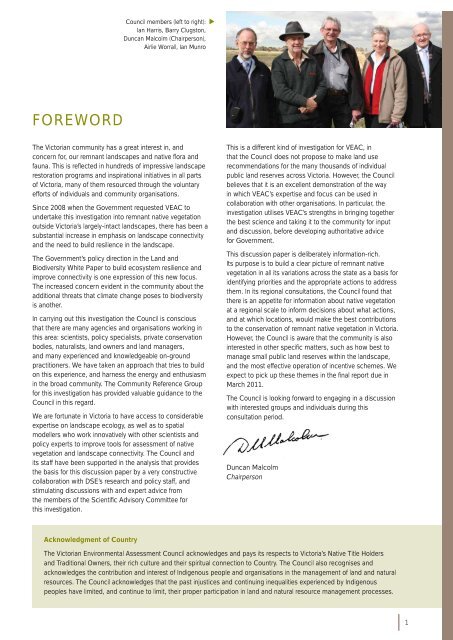Remnant Native Vegetation Investigation Discussion Paper
Remnant Native Vegetation Investigation Discussion Paper
Remnant Native Vegetation Investigation Discussion Paper
You also want an ePaper? Increase the reach of your titles
YUMPU automatically turns print PDFs into web optimized ePapers that Google loves.
Council members (left to right):<br />
Ian Harris, Barry Clugston,<br />
Duncan Malcolm (Chairperson),<br />
Airlie Worrall, Ian Munro<br />
<br />
FOREWORD<br />
The Victorian community has a great interest in, and<br />
concern for, our remnant landscapes and native fl ora and<br />
fauna. This is refl ected in hundreds of impressive landscape<br />
restoration programs and inspirational initiatives in all parts<br />
of Victoria, many of them resourced through the voluntary<br />
efforts of individuals and community organisations.<br />
Since 2008 when the Government requested VEAC to<br />
undertake this investigation into remnant native vegetation<br />
outside Victoria’s largely-intact landscapes, there has been a<br />
substantial increase in emphasis on landscape connectivity<br />
and the need to build resilience in the landscape.<br />
The Government’s policy direction in the Land and<br />
Biodiversity White <strong>Paper</strong> to build ecosystem resilience and<br />
improve connectivity is one expression of this new focus.<br />
The increased concern evident in the community about the<br />
additional threats that climate change poses to biodiversity<br />
is another.<br />
In carrying out this investigation the Council is conscious<br />
that there are many agencies and organisations working in<br />
this area: scientists, policy specialists, private conservation<br />
bodies, naturalists, land owners and land managers,<br />
and many experienced and knowledgeable on-ground<br />
practitioners. We have taken an approach that tries to build<br />
on this experience, and harness the energy and enthusiasm<br />
in the broad community. The Community Reference Group<br />
for this investigation has provided valuable guidance to the<br />
Council in this regard.<br />
We are fortunate in Victoria to have access to considerable<br />
expertise on landscape ecology, as well as to spatial<br />
modellers who work innovatively with other scientists and<br />
policy experts to improve tools for assessment of native<br />
vegetation and landscape connectivity. The Council and<br />
its staff have been supported in the analysis that provides<br />
the basis for this discussion paper by a very constructive<br />
collaboration with DSE’s research and policy staff, and<br />
stimulating discussions with and expert advice from<br />
the members of the Scientifi c Advisory Committee for<br />
this investigation.<br />
This is a different kind of investigation for VEAC, in<br />
that the Council does not propose to make land use<br />
recommendations for the many thousands of individual<br />
public land reserves across Victoria. However, the Council<br />
believes that it is an excellent demonstration of the way<br />
in which VEAC’s expertise and focus can be used in<br />
collaboration with other organisations. In particular, the<br />
investigation utilises VEAC’s strengths in bringing together<br />
the best science and taking it to the community for input<br />
and discussion, before developing authoritative advice<br />
for Government.<br />
This discussion paper is deliberately information-rich.<br />
Its purpose is to build a clear picture of remnant native<br />
vegetation in all its variations across the state as a basis for<br />
identifying priorities and the appropriate actions to address<br />
them. In its regional consultations, the Council found that<br />
there is an appetite for information about native vegetation<br />
at a regional scale to inform decisions about what actions,<br />
and at which locations, would make the best contributions<br />
to the conservation of remnant native vegetation in Victoria.<br />
However, the Council is aware that the community is also<br />
interested in other specifi c matters, such as how best to<br />
manage small public land reserves within the landscape,<br />
and the most effective operation of incentive schemes. We<br />
expect to pick up these themes in the fi nal report due in<br />
March 2011.<br />
The Council is looking forward to engaging in a discussion<br />
with interested groups and individuals during this<br />
consultation period.<br />
Duncan Malcolm<br />
Chairperson<br />
Acknowledgment of Country<br />
The Victorian Environmental Assessment Council acknowledges and pays its respects to Victoria’s <strong>Native</strong> Title Holders<br />
and Traditional Owners, their rich culture and their spiritual connection to Country. The Council also recognises and<br />
acknowledges the contribution and interest of Indigenous people and organisations in the management of land and natural<br />
resources. The Council acknowledges that the past injustices and continuing inequalities experienced by Indigenous<br />
peoples have limited, and continue to limit, their proper participation in land and natural resource management processes.<br />
1
















